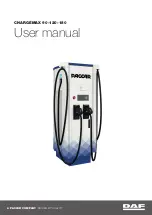
G
Risk of accident
Tyre pressure that is either too high or too low
has a negative effect on the vehicle’s driving
safety, which could lead you to cause an acci-
dent. Therefore, you should regularly check
the pressure of all the tyres, particularly prior
to long trips, and correct the pressure as nec-
essary.
To test tyre pressure, use a suitable pressure
gauge. The outer appearance of a tyre does
not permit any reliable conclusion about the
tyre pressure. On vehicles fitted with the elec-
tronic tyre pressure monitor*, the tyre pres-
sure can be checked in the on-board com-
puter.
G
Risk of accident
Do not fit anything else to the tyre valve other
than the standard valve cap. In particular, ret-
rofitted tyre pressure monitors which are
screwed on to the valve may overload it and
cause it to fail. Due to their design, the valve
is kept open continuously, which may lead to
air loss.
G
Risk of accident
Should the tyre pressure drop repeatedly:
R
check the tyre for foreign bodies.
R
check whether the wheel is losing air or the
valve is leaking.
R
make sure that only a valve cap approved
by Mercedes-Benz has been fitted on the
tyre valve.
Tyre pressures that are too low have a nega-
tive effect on vehicle safety, which could lead
to your causing an accident.
If possible, you should only correct tyre pres-
sures when the tyres are cold. Depending on
the ambient temperature, the speed you are
driving at and the load on the tyres, the tyre
temperature and thus the tyre pressure may
change by approximately 0.1 bar per 10 †.
Take this into account when checking the
pressure of warm tyres and only correct it if
it is too low for the current operating condi-
tions.
Driving with tyre pressure that is too high or
too low can:
R
shorten the service life of the tyres
R
increase the likelihood of tyre damage
R
have a negative effect on handling charac-
teristics (e.g. by causing aquaplaning)
i
The tyre pressure values given for low
loads are minimum values which offer you
good ride comfort characteristics.
However, you can also use the values given
for higher loads. These are permissible and
will not adversely affect the running of the
vehicle.
Also check the tyre pressure of the spare
wheel*.
H
Environmental note
Check the tyre pressure regularly, at least
every 14 days.
Tyre pressure information:
the values on the tyre pressure information
label (fuel filler flap) are for the use of the
vehicle in partially laden and fully laden con-
dition whilst driving at maximum speed.
Despite the values stated on the tyre pressure
information label, for the vehicle with "parti-
ally laden up to 210 km/h" status, the val-
ues can be reduced as follows, without a
reduction in safety:
-0.4 bar/-6 psi: all models without
4MATIC, not S 600 and not
S 420 CDI
-0.3 bar/-4 psi: all models with 4MATIC,
S 600 and S 420 CDI
This improves the ride comfort of your vehi-
cle; however, the fuel consumption may
increase slightly.
320
Tyres and wheels
Oper
ation
* optional
221_AKB; 2; 3, en-GB
bjanott,
Version: 2.11.7.7
2009-02-27T14:56:10+01:00 - Seite 320
Dateiname: 6515231002_buchblock.pdf; erzeugt am 03. Mar 2009 15:18:25; WK
















































